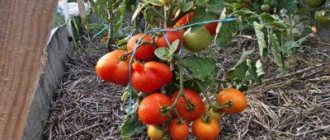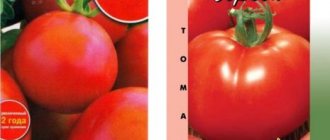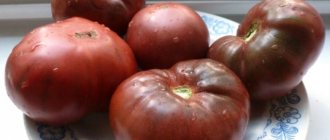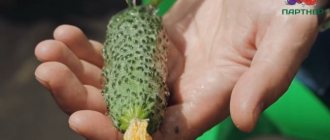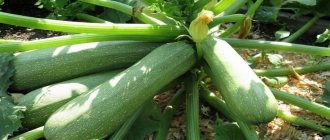The Goose Egg tomato is a popular crop variety that received its name for the unusual shape of the tomatoes. The species was created through the efforts of breeders in 2010. Despite the fact that it is a new product, it has already become widespread among gardeners due to its stable yield and unpretentiousness to growing conditions. However, the variety has not yet been registered in the State Register.
Goose egg is a bee-pollinated crop variety
Description of tomato variety Goose egg with photo
This species is classified as indeterminate, which means that the growth of its shoots is unlimited in the presence of favorable conditions. You can grow the Goose Egg tomato in greenhouses and open ground. The height of the bushes in the first case reaches 2 m, and in the second - 1.7-1.8 m.
The plant is densely leafy and spreading, so throughout the season it is necessary to form a bush and remove stepsons. Also, when growing the species, it is necessary to use supports.
Important! Bushes of this variety show maximum performance when forming 1-2 shoots.
The leaf blades of the species are of standard size and dark green in color. The inflorescences are simple. The first fruit cluster grows above the 7-8th leaf, and subsequently every three. Each of them contains 4-8 fruits, which ensures good yield. It is noteworthy that at the bottom of the bush there are more tomatoes, but they are smaller in size than at the top.
When five fruit clusters are formed, the main shoot must be pinched so that all the tomatoes have time to ripen before frost arrives. The bushes begin to bear fruit at 110-115 days. The ripening of the crop occurs gradually.
Important! Goose egg tomato seeds can be used for sowing, as this species is a cultivar.
Description of fruits
Tomatoes Goose egg, as shown in the photo, is oval-round in shape. Some specimens have ribbing near the stalk. The average weight of tomatoes is 200-300 g, and some weigh up to 350 g. The color of the fruit when ripe changes from dark pink to rich red.
The pulp is fleshy, elastic, strong. When cutting tomatoes, no liquid comes out. The taste of the fruit is sweetish with a slight hint of acid. Goose egg tomatoes have a rich tomato aroma.
The skin is thin and dense, but when the fruit ripens it can be easily separated from the pulp. Tomato Goose egg is not damaged during transportation and long-term storage. When harvested at the stage of technical maturity, tomatoes retain commercial quality and taste for 45 days.
The ripening of tomatoes on the fruit cluster occurs almost simultaneously. In this case, it is necessary to immediately collect them, since they can crumble under their own weight.
Important! Goose egg tomatoes contain a small amount of seeds, so this must be taken into account when collecting planting material.
Characteristics of tomatoes
Tomatoes of this variety have the following characteristics:
- The shape of the tomatoes is well reflected in the name of the variety - they actually somewhat resemble a large egg. But the shape can vary somewhat depending on growing conditions, and the surface of the skin can be either completely smooth or with significant folds at the base of the stalk.
- The fruits are initially green in color with a pronounced dark spot at the stalk. When ripe they turn orange-red. The stain disappears completely.
- Manufacturers characterize these tomatoes as having high pulp density, but consumer opinions differ on this point. Some agree with this assessment, while others believe that the flesh cannot be called dense, especially when fully ripe.
- The skin of tomatoes is very thin and can be easily removed from the fruit.
- Tomatoes could be called cream, but they are much larger in size than regular cream. On average, the weight of the fruit is about 200 grams, but in the upper clusters the weight of many fruits reaches 300 grams. Therefore, the Goose Egg variety is often classified even as a large-fruited tomato.
- Taste characteristics can be called good and excellent. Despite the fact that the manufacturer calls this variety of tomatoes one of the best for pickling, they are also quite good for fresh consumption in salads.
- Due to its dense consistency and significant amount of dry matter, the fruits of this variety are suitable for drying, drying and freezing.
- The safety and transportation of fruits is very high. Can be stored in cool conditions for up to 45 days.
- Tomatoes ripen very well when picked green. Although, according to some reviews from gardeners, fully ripe tomatoes of this variety do not last as long as we would like.
Characteristics of tomato Goose egg
When choosing such a variety, you should study its main characteristics. This information will allow each gardener to learn in more detail the characteristics of the species and achieve maximum efficiency.
Tomato yield Goose egg and fruiting
Goose egg is a mid-early variety. The first harvest of fruits can be carried out in the last days of July or early August. Productivity per 1 sq. m in open ground is 7-9 kg. To increase it, it is necessary to timely fertilize and water the bushes. Since any lack of nutrition can negatively affect the quality and quantity of tomatoes.
The harvest in open ground is better than in a greenhouse
The harvest in open ground is better than in a greenhouse
Area of application of fruits
Tomato Goose Egg is universal in use. Tomatoes can be eaten fresh or processed. But due to the large size of the fruit, this species is not suitable for whole-fruit pickling or canning in jars.
Goose egg is best used for cooking:
- juice;
- pastes;
- sauce;
- lecho;
- salads;
- assorted vegetables.
Important! During heat treatment, the pulp retains its structure, but changes its taste slightly.
Resistance to diseases and pests
Goose eggs, like many other types of Siberian selection, have high natural immunity to common diseases, such as:
- late blight;
- crown rot;
- various types of spotting;
- mosaic.
Also, this species easily tolerates short-term drought, cool conditions and temperature changes.
When growing tomatoes in a greenhouse, it is possible to suffer from whitefly, and in open ground – from the Colorado potato beetle at the initial stage of seedling growth.
Description of fruits
Scorpio is a large-fruited variety. The average weight of a tomato is 400 grams, but there are representatives of 800 grams. Vegetables are perfect for cutting fresh salads, preparing tomato juice and sauces, as well as preserving in pieces.
The tomatoes are quite juicy and covered with a thin, dense skin that protects the tomato from cracking. Vegetables have a flat-round shape and weak ribbing. The tomato has a balanced taste with a sweetish aftertaste. Vegetable colors may vary. There are colors from bright red to soft pink. The color depends on how much sun hits the bush. The more sun, the more saturated the color. Vegetables are stored well and can withstand transportation. Due to their excellent taste and keeping quality, tomatoes of this variety are used for commercial purposes.
Pros and cons of the variety
Goose eggs have a number of advantages and some disadvantages. Therefore, when choosing this variety, it is necessary to take them into account so that the desired result corresponds to reality.
The taste of fruits improves as they ripen
pros
- suitable for any region;
- excellent presentation;
- resistance to fruit cracking;
- low maintenance requirements;
- high natural immunity;
- easy to transport;
- suitable for long-term storage;
- good taste of tomatoes.
Minuses
- average level of yield compared to other tall species;
- needs additional support;
- requires the formation and pinching of bushes.
Advantages and disadvantages
Valuable qualities can be considered:
- Resistance to late blight;
- Undemanding to lighting, which is important for Siberia;
- High yield;
- Rich sweet and sour taste;
- Excellent transportability.
The positive characteristics of the variety include: originality and taste of the fruit, unpretentiousness, resistance to weather changes and diseases.
Disadvantages: the bush needs shaping and staking, average yield.
Density is an important advantage of tomatoes. Thanks to this characteristic, they do not crack on the branch, are stored for a long time when picked (up to 1.5 months), and can withstand transportation without any problems. The fruits are suitable for ripening. Other advantages of tomato:
- Possibility of growing in different parts of the Russian Federation.
- Extended fruiting. The harvest will mature before the autumn frosts.
- Good taste. It is preserved not only fresh, but also in juices and sauces. This tomato is also suitable for drying or drying.
- Convenient form for preservation. The tomatoes can be easily placed in the jar in even rows.
- Thin skin that will not interfere with the taste sensations. If desired, it can be removed without harm to the pulp.
Attention! Noticed: slightly overripe tomatoes taste better. But the duration of lying down in this case is reduced.
There are also disadvantages:
- average yield;
- tomatoes grow larger in a greenhouse;
- Beef fruits have few seeds;
- the tomato is very tall and needs support;
- good fruiting is possible only with the correct formation and constant removal of stepsons.
- Resistance to late blight;
- Undemanding to lighting, which is important for Siberia;
- High yield;
- Rich sweet and sour taste;
- Excellent transportability.
Among the disadvantages, one can note the labor intensity in caring for spreading and very tall bushes. However, it is obvious that the variety has many more advantages.
There are also disadvantages:
- average yield;
- tomatoes grow larger in a greenhouse;
- Beef fruits have few seeds;
- the tomato is very tall and needs support;
- good fruiting is possible only with the correct formation and constant removal of stepsons.
Features of cultivation
By the time of planting in the ground, the age of the seedlings should be 55-60 days. Therefore, the optimal period for sowing when growing tomatoes in a greenhouse is the first half of March, in open ground - the last week of this month. The seeds must first be prepared. To do this, you need to soak them in a weak solution of potassium permanganate for 15 minutes, and then rinse with clean water and dry until free-flowing.
Important! It is better to treat the seeds immediately before planting, since after this they cannot be stored.
For sowing, it is necessary to prepare a substrate of turf, sand, humus and peat in a ratio of 2:1:1:1. Before planting, it should be disinfected with a solution of potassium permanganate. You also need to prepare wide containers 10 cm high, which should have drainage holes to drain water.
Procedure:
- Fill containers with substrate and water.
- Compact the soil on top.
- Place the seeds at a distance of 1.5-2 cm.
- Sprinkle a layer of soil on top - 0.7-1 cm, moisten with a spray bottle.
After planting, cover the containers with film and place in a dark place with a temperature of +24-+25 degrees. When friendly shoots appear, which happens on the 4-5th day, the containers need to be moved to the windowsill, and the maintenance regime should be lowered to +18 degrees, which will enhance the growth of the root system of the seedlings. After a week, the temperature should be raised to +20 degrees.
When the tomatoes grow two true leaves, the seedlings need to be pruned. At the same time, you should not place the seedlings too close to each other so that they do not stretch out.
They should be planted in a permanent place in a greenhouse in early May, and in open ground in the first ten days of June. Planting should be carried out at the rate of three seedlings per 1 square meter. m. You need to install a support nearby in order to be able to tie up the shoots in time.
The bush should be formed into 1-2 stems, and the remaining stepsons should be removed so that the plant does not waste energy.
Goose egg tomatoes should be watered moderately twice a week, but the soil should be wet to a depth of 20 cm. To do this, use settled water.
It is necessary to fertilize the bushes three times a season. For the first time - two weeks after planting in the ground. At this time, you can use organic matter and mineral fertilizers with a high nitrogen content. The second and third feeding should be carried out at the stage of flowering and fruit formation. During this period, you need to use phosphorus-potassium mixtures.
When growing in a greenhouse, it is recommended to lay mulch from humus or peat at the base of the bushes, which will reduce watering and prevent excessive evaporation.
Diseases
Goose Egg, bred in Siberian conditions, is therefore generally quite resistant to many types of diseases (for example, late blight) common among other tomatoes. But in order to avoid infections, it is better to apply some measures to prevent diseases:
- Before planting in a greenhouse or soil, remove the top layer of soil to disinfect the soil from possible fungal spores.
- Tomatoes need to be treated with preparations containing copper or sulfur.
- Seedlings and bushes can be treated with fungicides and garlic solution. This treatment is carried out three times - 20 days after planting in the ground, the second time - after 40 days of planting, and during the flowering period of the brushes.
Whatever the resistance of the variety to diseases and infections, by doing all these simple manipulations, you can protect your plot and crop from infection.
Pest and disease control
Despite the high resistance of the Goose Egg tomato to common diseases, preventive treatment of bushes with fungicides is necessary three times a season. This should be done for the first time 14 days after planting, and then repeated every two weeks.
Also, when planting, you should first soak the root system of seedlings in the Confidor Extra working solution, which will prevent damage to the Colorado potato beetle.
If whiteflies appear when growing in a greenhouse, you should water the bushes with Aktara and spray the leaves with Aktellik.
Basics of growing large-fruited tomatoes
Large-fruited tomatoes in most cases are indeterminate varieties, so they give maximum yield when grown in closed greenhouses. Gardeners can be confident in the productivity of plantings and high yields.
When deciding to plant large, fleshy tomatoes, you need to realize that a large number of indeterminate varieties exhibit rapid and vigorous growth vertically upward, as well as around the circumference and sides.
The leaf axils are filled with young shoots that grow into new stems covered with racemose clusters of flowers.
By leaving such plants to grow uncontrollably, you run the risk of not reaching final maturity and the desired harvest. Nutrients will go to shoots instead of fruits.
Key points for obtaining large tomatoes:
- Always remember about pinching - removing young shoots at the moment of their appearance, so that 2-3 strong stems remain. The process is repeated periodically, since the growth of shoots does not stop until the plant has spent its strength. Leaving short stumps in place will help reduce their number in the future.
- Monitor the number of flower clusters on the stems, limiting yourself to five to six inflorescences.
- When the bush reaches the limit of the variety, pinch the top above the inflorescence without touching the top few leaves. This will help to properly distribute nutrients throughout the plant and produce better fruits.
- As the fruits increase, especially in large-variety tomatoes, the load on the bush also increases. A well-organized garter will help. It is best to install metal or plastic trellises with wire stretched between them. Strings or strong cords are tied onto the wire, ideal for plants to wrap around them and grow in size. Fruit clusters can be tied with additional ropes.
- And most importantly, do not forget about the varietal selection of large tomatoes.
Transfer
- Before planting in the ground, the seedlings need to be hardened off: they are taken outside every day for a week.
- The soil in the garden bed is watered with a solution of manganese and loosened.
- Since the indeterminate variety requires tying, a trellis is immediately installed.
- Plants are planted at a distance of 50 cm from each other and watered with warm water at the root.
Bushes are formed into 1-2 stems, removing side shoots and pinching out the growing point. Shoots weighed down with fruits also need to be tied up. Watering is done once every two weeks in spring and once a week in summer.
Use warm water, water at the root or drip. The procedure can be combined with fertilizing using a solution of mineral or organic fertilizers.
After this, the soil is loosened, facilitating air access to the root system. Fertilizing is carried out once every 14 days, alternating mineral complexes and organic matter.
During flowering and fruiting, additional potassium fertilizing can be done. To control humidity levels and prevent diseases, the greenhouse is regularly ventilated.
Watering and fertilizing
On the day below, after planting the seedlings or after the emergence of seedlings, the bed with plants is loosened to improve the water-air regime in the top layer of soil.
- Subsequently, loosening is carried out two or three times until the tomatoes grow, covering the entire meter of the bed.
- Fertilizing is carried out before flowering and before fruit formation.
- The first feeding of goose eggs tomatoes is carried out with a solution that includes fifty grams of superphosphate, thirty grams of potassium nitrate and twenty-five grams of ammonium sulfate, take ten liters of warm, settled water.
- One liter of solution is poured under each bush. During further feeding, prepare a solution in the following composition: fifty grams of superphosphate and potassium nitrate in ten liters of water. Two liters of solution is applied to each plant.
- For fertilizing, you can use organic vitamins (earths. Consumption of organic fertilizers (mullein solution 1/10 or essence of bird droppings 1/20, respectively) for the first fertilizing - a couple of liters per plant, for the second fertilizing - up to four liters take the plant. The interval between the first and the second feeding is ten to a dozen days.
- Tomatoes are watered only with warm water that has been left to float to the root. To improve the use of water when watering the bushes, a border of soil is made around them in a circle.
Humidification is carried out in several stages, as water is absorbed. There are no words for the time of fruiting, the plant’s water consumption increases, so watering is carried out more often and more intensively.
To die and not get up during watering, it is undesirable to wet the soil under the fruits; they will rot if damp. The Goose Egg variety has a measure of bush growth. In case of strong growth, large leaves should be removed for better illumination of the ovaries, and therefore greater yield.
Indeterminate varieties
Among large-fruited tomato varieties, indeterminate types are most suitable for milking greenhouses. This group of tomatoes is distinguished by a powerful branched vine-type bush, in which all shoots (including lateral ones) actively bear fruit. At the same time, the plants reach great heights, which allows you to harvest more vegetables from one bed. The main thing to remember is that such tomatoes need to be planted at a distance of 45-60 cm from each other and take care in advance about how to garter the tomatoes in the greenhouse.
Mazarin
This is an indeterminate variety, early ripening (ripening 100-120 days), excellent for growing in greenhouses. They take root best in the southern regions, but can also grow in temperate zones. The bushes reach a height of 1.8-2 meters, there is a lot of heavily cut foliage, and one brush produces 6-8 ovaries. The fruits are heart-shaped, large, weighing up to 700 grams, red, sweet and fleshy. The Mazarin variety keeps well. Another advantage is its resistance to temperature changes and the main diseases of the nightshade family. The main disadvantage of the variety is the need for regular pinching and gartering of each hand.
Mazarin tomato variety
Mazarin's largest fruits grow from the first ovaries. Later, and they bear fruit until frost, tomatoes reach no more than 400-450 g.
Scorpio largefruited
A mid-season variety bred specifically for cultivation in greenhouse conditions. It does not form many ovaries, 3-4 per hand. But the tomatoes grow large, weighing up to 900 g, have a rounded-flat shape and are strongly striated from bottom to top. The thick skin is pink to crimson in color. There are few seed chambers, only sugar pulp. Strongly depends on environmental conditions, and most of all on illumination, needs long daylight hours.
Tomato variety "Scorpion large-fruited"
Cardinal
A mid-early tomato variety that takes root well in cold temperate climates and in the southern regions of the country. It is distinguished by excellent germination and high resistance to all nightshade scourges. The yield is close to 16-18 kg per square meter, and the weight of 1 tomato reaches 900 grams. The clusters bear up to 10 full-fledged heart-shaped fruits with a sweetish taste. The fruit is juicy due to the large number of seed chambers. The stem reaches a height of 1.5 meters, but is not reliable, so it is necessary to provide a separate support for each brush.
Tomato variety "Cardinal"
Soft large fruits are suitable for fresh consumption or preparations such as ketchup, lecho, tomato paste. It is impossible to pickle them, so for pickling you will have to plant another variety.
Bear Paw
A high-yielding variety that is mid-early. The fruits ripen large, weighing up to 800 g, and ripen slowly throughout the season. The leaf is simple dark green, and the bushes are up to 2 meters in height. Bear paw is resistant to any climatic conditions and diseases. The ovaries are formed in clusters of 5-7 pieces. The skin is red, dense, glossy. The fruits are round in shape with juicy pulp. But the taste is not quite ordinary, it has a certain sourness.
Tomato variety "Bear's Paw"
Grandma's secret
That variety was developed relatively recently, but thanks to its many advantages it quickly gained popularity. The fruits are flattened, ribbed, crimson in color, and have 5-7 seed chambers. The largest fruits can weigh more than 1 kg, although not many ovaries are formed on the bush. The maximum number of brushes is 8; after the last one grows, it is necessary to pinch the main shoot. The bush itself is tall and dense, but still needs staking. In terms of ripening time, Grandma's secretion is mid-season and has good immunity to powdery mildew, tobacco mosaic and other diseases.
Tomato variety "Grandma's Secret"
To increase the shelf life of fruits, it is recommended to collect them before they are fully ripe. Green fruits are easily transported and ripen in a short time.
De Barao the giant
An unusual tomato that has long been loved by gardeners. This tomato is also called . Its main advantage is its excellent taste, which everyone will like. The mass is not so large, no more than 500 grams, but the shape is extremely unusual and resembles a plum. The height of the bush exceeds 2.5 meters, little greenery grows. Not many bunches are formed, but each one brings 8-11 tomatoes. The variety is late-ripening, perfectly stored and transported. It is easy to care for; the only thing it needs is regular watering.
Tomato variety "De Barao Giant"
When pinching, it is recommended to leave 2 of the largest shoots per bush, this way you can achieve maximum results.
Reviews
Samarin Maxim Olegovich, 56, Moscow Tomato Goose egg has been grown in our family for several years: the variety is mid-season, so we stick with tomatoes all summer. The bush is tall, so you need not only to build supports, but also to choose a place in the garden so that there is enough sunlight. There were no problems with pests or diseases. Akunina Larisa Igorevna, 47 years old, Adler variety Goose eggs have been grown for the first year. Among the positive qualities are good harvests and simultaneous ripening of fruits. The plant is unpretentious, tolerates drought and rare feeding. Among the disadvantages is the high risk of developing diseases without taking preventive measures.
Source – https://agrognom.ru/vegetables/tomatoes/tomat-gusinoe-yajtso-otzyvy-foto-urozhajnost.html
Tomatoes Big Mommy on video
If you grew Big Mom tomatoes, please write whether you liked them or not. What was the yield and taste of the fruits like under your climatic conditions? How do you rate the disease resistance of this tomato? Briefly describe the advantages and disadvantages of the variety in your opinion. If possible, attach a photo of the entire bush or individual fruits you grew to your comment. Thank you!
Your reviews of the Big Momma tomato and additions to the description will help many gardeners evaluate this variety more objectively and decide whether it is worth planting or not.
This is a natural variety of tomato. Therefore, we recommend taking seeds from a ripe fruit and using them for planting in subsequent seasons.
Original tomato seeds
Cultivating non-hybrid varieties is considered a more risky activity, but these best seeds successfully retain all their properties. Thus, you can independently develop your own method of growing this nightshade crop.
Universally used fruits of the Dubrava variety
The biological description of the variety and characteristics of the Dubrava tomato indicate that the plant is intended for open soil. The bushes grow determinately in recommended conditions up to 60 cm. Ripe tomatoes are round, with small brown spots. The fruit ripens in literally 85-105 days and grows up to 110 g. Some reviews of the Dubrava tomato suggest that the variety will produce a harvest in a polycarbonate greenhouse. The plant at any stage of development requires sunlight. For this variety, it is recommended to choose sandy loam, light loamy soils. A high humus content is allowed. The yield increases with fertilizing.
Thumbelina
The indeterminate variety is early ripening (90-95 days). Protected soil and polycarbonate greenhouses are the best conditions for the development and fruiting of Thumbelina. For a good harvest, the plant should be shaped and, if necessary, tied to trellises. There are up to 15 fruits in one brush. Red tomatoes are moderately sweet, weighing 15-20 g. The grape-shaped variety is recommended for fresh consumption.
The few negative reviews about the Thumbelina tomato concern the taste of ripe vegetables. Some gardeners note that the variety is sour. In this case, most likely, the bushes were grown in conditions of insufficient natural light.
Pear-shaped Dulcinea
The mid-season tomato Dulcinea produces beautiful raspberry fruits. Large pear-shaped vegetables ripen on a plant up to 160 cm high. In greenhouse conditions, the largest tomatoes can reach 350 g, the average weight is about 200 g. Per 1 sq.m. Seed manufacturers recommend planting three plants at a time. A garter is necessary for an adult bush. Timely fertilizing helps increase the yield of tomatoes.
When cultivating Dulcinea, it is important to know that the first cluster is planted above the 7th leaf. Each subsequent one is after 3 sheets. One inflorescence is 4-6 fleshy fruits with aromatic pulp
Tomatoes, delicate in texture, perfectly complement vegetable dishes. The pleasant taste of ripe tomatoes is due to the harmonious combination of sugars and acids
One inflorescence is 4-6 fleshy fruits with aromatic pulp. Tomatoes, delicate in texture, perfectly complement vegetable dishes. The pleasant taste of ripe tomatoes is due to the harmonious combination of sugars and acids.
Stable in harvest Siberian trump card
A rare variety produces such yields: one fruit reaches 700 g. Due to its characteristics (primarily, resistance to temperature changes and stress), the variety grows well in open ground and is of little use for greenhouse cultivation. But reviews of the Siberian Trump tomato allow us to talk about excellent harvests in greenhouses. The main thing is to protect the plant from pests and viruses.
The fruits ripen on a determinate spreading bush (height up to 80 cm). In any growing conditions, pinching is recommended only up to the first flower cluster. The first and last harvests are large-fruited, so you will need to install trellises. Ripe tomatoes are raspberry-red, flattened, round, ribbed.
General overview of the best large-fruited varieties
So, the time has come to get acquainted with large-fruited tomatoes, which have gained popularity among domestic summer residents. These varieties can rightfully be called the best, and we will now get to know them.
Wonder of the earth
The variety of domestic selection is zoned in all regions of the country. The stems of the plant do not grow more than 1 m in height, the bushes are slightly spreading. There is a slight ribbing on the walls of round tomatoes. Raspberry fruits grow large, weighing up to 700 g. Occasionally it is possible to grow tomatoes weighing more than 1 kg. In the northern regions, the yield is lower, up to 15 kg/m2, and in the south it reaches 20 kg/m2.
Alsou
The determinate variety of Siberian selection has a yield of 9 kg/m2. The stems grow up to 0.8 m in height. The crop bears fruit well even in open ground. Medium-sized tomatoes weigh 300 g. From the first ovary you can get fruits weighing up to 800 g.
Black elephant
Despite the unusual dark brown color, tomatoes have long gained popularity among domestic vegetable growers. The crop is considered mid-season, but successfully manages to produce a harvest in the northern regions. An indeterminate plant bears fruits with clearly visible ribbing on the walls. The vegetable weighs a maximum of 300 g. When fully ripe, light spots appear on the skin.
Delicious
The variety of American selection is distinguished by the exquisite taste of aromatic tomatoes. The fruits grow large, weighing up to 600 g, sometimes they are more than 1 kg. An indeterminate plant is able to adapt to any growing conditions. The bushes form two stems, sometimes even leaving three shoots. The variety belongs to the mid-season group.
King of Siberia
This indeterminate variety will appeal to lovers of yellow tomatoes. The culture is adapted in all regions of the country. The yellow pulp is considered dietary and is suitable even for allergy sufferers. The plant has a powerful bush structure and is poorly covered with foliage. Heart-shaped ribbed fruits weigh up to 400 g.
Nobleman
The variety is adapted for cultivation in risky farming zones. According to the ripening period, it belongs to mid-ripening tomatoes. The stems grow up to 70 cm in height. On the walls of the heart-shaped fruits, ribbing is visible. The average weight of a vegetable is 200 g, but can grow up to 500 g. The yield is high, up to 30 kg/m2. The plant loves regular watering and feeding.
The video shows the “Velmozha” variety:



